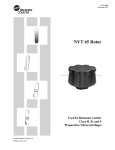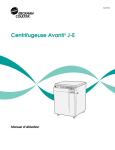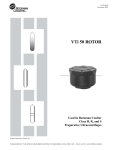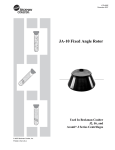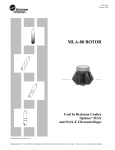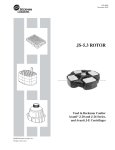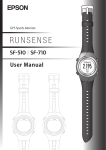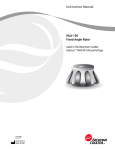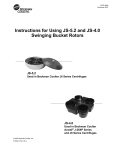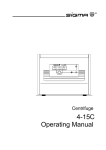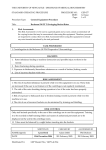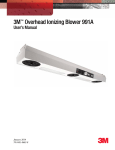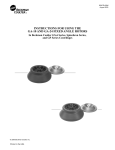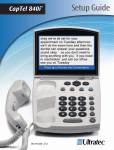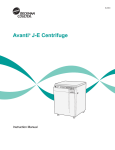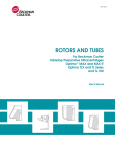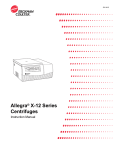Download Optima L Series
Transcript
LL-IM-9 Optima™ L Series Preparative Ultracentrifuges Symbol Symbol Symbole Símbolo Simbolo Title / Titel / Titre / Titulo Dangerous voltage Gefährliche elektrische Spannung Courant haute tension Voltaje peligroso Pericolo: alta tensione ! Attention, consult accompanying documents Achtung! Begleitpapiere beachten! Attention, consulter les documents joints Atención, consulte los documentos adjuntos Attenzione: consultare le informazioni allegate On (power) Ein (Netzverbindung) Marche (mise sous tension) Encendido Acceso (sotto tensione) Off (power) Aus (Netzverbindung) Arrêt (mise hors tension) Apagado Spento (fuori tensione) Protective earth (ground) Schutzleiteranschluß Liaison à la terre Puesta a tierra de protección Collegamento di protezione a terra Earth (ground) Erde Terre Tierra Scarica a terra / Titolo / ! SAFETY NOTICE This safety notice summarizes information basic to the safe operation of the equipment described in this manual. The international symbol displayed above is a reminder that all safety instructions should be read and understood before installation, operation, maintenance, or repair of this instrument. When you see the symbol on other pages, pay special attention to the safety information presented. Observance of safety precautions will also help to avoid actions that could damage or adversely affect the performance of the equipment. Other symbols may also be displayed on the equipment. These are reproduced and described under CONVENTIONS below and on the inside of the front cover. Safety During Installation and/or Maintenance This instrument is designed to be installed by a Beckman Coulter Field Service representative. Installation by anyone other than authorized Beckman Coulter personnel invalidates any warranty covering the instrument. Also, should the instrument need to be moved, a Beckman Coulter Field Service representative must reinstall and relevel the instrument in its new location. Any servicing of this equipment that requires removal of any covers can expose parts which involve the risk of electric shock or personal injury. Make sure that the power switch is turned off and the instrument is disconnected from the main power source, and refer such servicing to qualified personnel. Do not replace any centrifuge components with parts not specified for use on this instrument. Electrical Safety To reduce the risk of electrical shock, this instrument uses a three-wire electrical cord and plug to connect this equipment to earth-ground. Make sure that the matching wall outlet receptacle is properly wired and earth-grounded. Do not place containers holding liquid on or near the chamber door. If they spill, liquid may get into the instrument and damage electrical or mechanical components. Safety Against Risk of Fire Fuses protect certain electrical circuits within this instrument against overcurrent conditions. For continued protection against the risk of fire, replace only with the same type and rating specified. This instrument is not designed for use with materials capable of developing flammable or explosive vapors. Do not centrifuge such materials (for example, chloroform or ethyl alcohol) in this instrument nor handle or store them near the centrifuge. Mechanical Safety For safe operation of the equipment, observe the following: • Use only the Beckman Coulter rotors and accessories designed for use in this instrument. • Do not exceed the maximum rated speed of the rotor in use. • NEVER attempt to slow or stop a rotor by hand. • Do not move the centrifuge while the drive motor is spinning. • In the event of a power failure, do not attempt to retrieve the sample from the instrument for at least one hour. Then follow the instructions for recovery of the sample under TROUBLESHOOTING AND MAINTENANCE. Chemical and Biological Safety Normal operation may involve the use of solutions and test samples that are pathogenic, toxic, or radioactive. Such materials should not be used in this instrument, however, unless all necessary safety precautions are taken. • Handle body fluids with care because they can transmit disease. No known test offers complete assurance that they are free of micro-organisms. Some of the most virulent— Hepatitis (B and C) and HIV (I-V) viruses, atypical mycobacterium, and certain systemic fungi—further emphasize the need for aerosol protection. Handle other infectious samples according to good laboratory procedures and methods to prevent spread of disease. Because spills may generate aerosols, observe proper safety precautions for aerosol containment. Do not run toxic, pathogenic, or radioactive materials in a rotor without taking appropriate safety precautions. Biosafe containment should be used when Risk Group II materials (as identified in the World Health Organization Laboratory Biosafety Manual) are handled; materials of a higher group require more than one level of protection. • Dispose of all waste solutions according to appropriate environmental health and safety guidelines. It is your responsibility to decontaminate the instrument and accessories before requesting service by Beckman Coulter Field Service. LL-IM-9 September 2005 Optima™ L Series Preparative Ultracentrifuges Instruction Manual © 2005 Beckman Coulter, Inc. Printed in the U.S.A. Contents Page INTRODUCTION Instrument Certification . . . . . . . . . . . . . . . . . . . . . . . . . . . . . . . . . . . . vii Scope of Manual . . . . . . . . . . . . . . . . . . . . . . . . . . . . . . . . . . . . . . . . . . vii Conventions . . . . . . . . . . . . . . . . . . . . . . . . . . . . . . . . . . . . . . . . . . . . viii Radio Inteterference . . . . . . . . . . . . . . . . . . . . . . . . . . . . . . . . . . . . . . . ix Specifications . . . . . . . . . . . . . . . . . . . . . . . . . . . . . . . . . . . . . . . . . . . . x Preinstallation Requirements . . . . . . . . . . . . . . . . . . . . . . . . . . . . . . . . xii SECTION 1: DESCRIPTION Power . . . . . . . . . . . . . . . . . . . . . . . . . . . . . . . . . . . . . . . . . . . . . . . . . 1-1 Standby Mode . . . . . . . . . . . . . . . . . . . . . . . . . . . . . . . . . . . . . . . 1-1 Key Switch Positions . . . . . . . . . . . . . . . . . . . . . . . . . . . . . . . . . . . . . 1-2 Control Panel . . . . . . . . . . . . . . . . . . . . . . . . . . . . . . . . . . . . . . . . . . . 1-2 Keys . . . . . . . . . . . . . . . . . . . . . . . . . . . . . . . . . . . . . . . . . . . . . . . 1-2 Displays . . . . . . . . . . . . . . . . . . . . . . . . . . . . . . . . . . . . . . . . . . . . 1-3 Run Status Indicators . . . . . . . . . . . . . . . . . . . . . . . . . . . . . . . . . . 1-4 Diagnostic Messages . . . . . . . . . . . . . . . . . . . . . . . . . . . . . . . . . . 1-4 Door . . . . . . . . . . . . . . . . . . . . . . . . . . . . . . . . . . . . . . . . . . . . . . . . . . 1-5 Rotor Chamber . . . . . . . . . . . . . . . . . . . . . . . . . . . . . . . . . . . . . . . . . . 1-5 Vacuum System . . . . . . . . . . . . . . . . . . . . . . . . . . . . . . . . . . . . . . . . . 1-6 Temperature Sensing . . . . . . . . . . . . . . . . . . . . . . . . . . . . . . . . . . . . . 1-6 Temperature Control System . . . . . . . . . . . . . . . . . . . . . . . . . . . . . . . 1-6 Overspeed System . . . . . . . . . . . . . . . . . . . . . . . . . . . . . . . . . . . . . . . 1-7 Rotor Energy System . . . . . . . . . . . . . . . . . . . . . . . . . . . . . . . . . . . . . 1-7 Drive . . . . . . . . . . . . . . . . . . . . . . . . . . . . . . . . . . . . . . . . . . . . . . . . . . 1-7 Name Rating Plate . . . . . . . . . . . . . . . . . . . . . . . . . . . . . . . . . . . . . . . 1-8 iii Contents Page SECTION 2: RUN PREPARATION Power . . . . . . . . . . . . . . . . . . . . . . . . . . . . . . . . . . . . . . . . . . . . . . . . . 2-1 Key Switch Positions . . . . . . . . . . . . . . . . . . . . . . . . . . . . . . . . . . . . . 2-1 Standard Operation. . . . . . . . . . . . . . . . . . . . . . . . . . . . . . . . . . . . . . . 2-2 Keypad . . . . . . . . . . . . . . . . . . . . . . . . . . . . . . . . . . . . . . . . . . . . . 2-2 Parameter Keys . . . . . . . . . . . . . . . . . . . . . . . . . . . . . . . . . . . . . . 2-3 Programmed Operation . . . . . . . . . . . . . . . . . . . . . . . . . . . . . . . . . . . 2-7 Activation Keys . . . . . . . . . . . . . . . . . . . . . . . . . . . . . . . . . . . . . . . . . 2-8 Delayed Start Program Function . . . . . . . . . . . . . . . . . . . . . . . . . . . 2-10 Entering Program 0 . . . . . . . . . . . . . . . . . . . . . . . . . . . . . . . . . . 2-10 Running Program 0 with a Second Program . . . . . . . . . . . . . . . 2-10 Editing Settings During the Delayed Start Run . . . . . . . . . . . . . 2-11 SECTION 3: RUN PROCEDURE Standard Operation. . . . . . . . . . . . . . . . . . . . . . . . . . . . . . . . . . . . . . . 3-2 Repeating a Run . . . . . . . . . . . . . . . . . . . . . . . . . . . . . . . . . . . . . . . . . 3-2 Programmed Operation . . . . . . . . . . . . . . . . . . . . . . . . . . . . . . . . . . . 3-2 Delayed Start Program Function . . . . . . . . . . . . . . . . . . . . . . . . . . . . 3-3 Zonal Operation . . . . . . . . . . . . . . . . . . . . . . . . . . . . . . . . . . . . . . . . . 3-4 Acceleration . . . . . . . . . . . . . . . . . . . . . . . . . . . . . . . . . . . . . . . . . 3-5 Deceleration . . . . . . . . . . . . . . . . . . . . . . . . . . . . . . . . . . . . . . . . . 3-5 Unloading. . . . . . . . . . . . . . . . . . . . . . . . . . . . . . . . . . . . . . . . . . . 3-6 Points to Remember . . . . . . . . . . . . . . . . . . . . . . . . . . . . . . . . . . . . . . 3-6 SECTION 4: TROUBLESHOOTING AND MAINTENANCE In Case of Power Failure During the Run . . . . . . . . . . . . . . . . . . . . . 4-1 Retrieving Your Sample . . . . . . . . . . . . . . . . . . . . . . . . . . . . . . . . . . . 4-2 Diagnostic Messages . . . . . . . . . . . . . . . . . . . . . . . . . . . . . . . . . . . . . 4-6 Cleaning . . . . . . . . . . . . . . . . . . . . . . . . . . . . . . . . . . . . . . . . . . . . . . . 4-7 Decontamination. . . . . . . . . . . . . . . . . . . . . . . . . . . . . . . . . . . . . . . . . 4-8 Sterilization and Disinfection . . . . . . . . . . . . . . . . . . . . . . . . . . . . . . . 4-8 Storage and Transportation. . . . . . . . . . . . . . . . . . . . . . . . . . . . . . . . . 4-8 Supply List . . . . . . . . . . . . . . . . . . . . . . . . . . . . . . . . . . . . . . . . . . . . . 4-9 Warranty iv Illustrations Page Figure 1-1. The Control Panel . . . . . . . . . . . . . . . . . . . . . . . . . . . . . . . . . . . . . . . . . 1-2 Figure 1-2. The Rotor Chamber. . . . . . . . . . . . . . . . . . . . . . . . . . . . . . . . . . . . . . . . 1-5 Figure 2-1. Inserting the Key Into the Interlock Switch . . . . . . . . . . . . . . . . . . . . . 2-2 Figure 4-1. Removing the Control Head Cover. . . . . . . . . . . . . . . . . . . . . . . . . . . . 4-3 Figure 4-2. Depressing the Latch to Loosen the Front Panel . . . . . . . . . . . . . . . . . 4-4 Figure 4-3. Interior View of Instrument . . . . . . . . . . . . . . . . . . . . . . . . . . . . . . . . . 4-5 Figure 4-4. Location of Diagnostic Messages on the Control Panel . . . . . . . . . . . . 4-6 Tables Page Table 1-1. Run Status Indicators . . . . . . . . . . . . . . . . . . . . . . . . . . . . . . . . . . . . . . 1-4 Table 2-1. Vacuum LEDs. . . . . . . . . . . . . . . . . . . . . . . . . . . . . . . . . . . . . . . . . . . . 2-9 Table 4-1. Diagnostic Troubleshooting Chart . . . . . . . . . . . . . . . . . . . . . . . . . . . . 4-7 v Introduction INSTRUMENT CERTIFICATION To assure full system quality, the Beckman Coulter Optima™ L series ultracentrifuges have been manufactured in a registered ISO 9001 facility. They have been designed and tested to be compliant (when used with Beckman Coulter rotors) with the laboratory equipment requirements of applicable regulatory agencies. Declarations of conformity and certificates of compliance are available at www.beckmancoulter.com. SCOPE OF MANUAL This manual is designed to familiarize you with the Beckman Coulter Optima L-100K or L-90K Preparative Ultracentrifuge—its function, specifications, operation, and routine operator care and maintenance. • The following introductory pages contain the instrument specifications and preinstallation requirements. • Section 1 provides a brief description of the instrument, the operating controls, and indicators. • Section 2 explains how to use the control panel to enter run parameters for standard and programmed operation. • Section 3 covers operating procedures for both kinds of runs. • Section 4 lists possible malfunctions, together with probable causes and corrective actions, and maintenance procedures. We recommend that you read this entire manual, especially the SAFETY NOTICE and all safety-related information, before operating or performing maintenance on this instrument. vii Introduction ➠ NOTE If the ultracentrifuge is used in a manner other than specified in this manual, the safety and performance of this instrument could be impaired. Further, the use of any equipment other than that intended for use by Beckman Coulter has not been evaluated for safety. Use of any equipment not specifically recommended in this manual is the sole responsibility of the user. To obtain additional copies of this manual, related rotor manuals, and other referenced publications, contact: Beckman Coulter, Inc. Technical Publications Department 1050 Page Mill Road Palo Alto, CA 94304, U.S.A. (Telephone 650-859-1753; Fax 650-859-1375) CONVENTIONS NOTES, CAUTIONS, AND WARNINGS Certain symbols are used throughout this manual to call attention to safety-related and other important information. The symbols used and their definitions are as follows: ➠ ! viii NOTE Used to call attention to important information that should be followed during installation, use, and/or servicing of this equipment. CAUTION Used to indicate a potentially hazardous situation which, if not avoided, may result in minor or moderate injury and/or mechanical damage. It is also used to alert against unsafe practices. Introduction ! WARNING Used whenever an action or condition may potentially cause serious personal injury or loss of life. Mechanical damage may also result. WARNING Indicates high voltage or risk of electric shock. Refer servicing of all areas displaying this symbol to service personnel. TYPOGRAPHIC CONVENTIONS Certain typographic conventions are used throughout this manual to distinguish names of user interface components, such as keys and displays. • Key names (for example, _78%68a or capital letters within boxes. ENTER/RECALL ) appear in • Display names (for example, TEMP°C or SPEED-RPM) appear in bold type. RADIO INTERFERENCE This instrument has been tested and found to comply with the limits for a Class A digital device, pursuant to Part 15 of FCC Rules. These limits are designed to provide reasonable protection against harmful interference when the equipment is operated in a commercial environment. This equipment generates, uses, and can radiate radio frequency energy and, if not installed and used in accordance with this instruction manual, may cause interference to radio communications. Operation of this equipment in a residential area may cause interference, in which case the user will be required to correct the interference at his or her own expense. ix Introduction CANADIAN REGULATIONS This digital apparatus does not exceed the Class A limits for radio noise emissions from digital apparatus as set out in the radio interference regulations of the Canadian Department of Communications. Le présent appareil numérique n’émet pas de bruits radioélectriques dépassant les limites applicables aux appareils numériques de Classe A prescrites dans le reglement sur le brouillage radioelectrique édicté par le Ministère des Communications du Canada. TEMP–˚C TIME–HR:MIN 7 8 9 4 5 6 1 2 3 TIME VACUUM–µ VACUUM SPEED SPEED–RPM 0 START CE STOP TEMP ACCEL DECEL w2t HOLD PROG ENTER/RECALL STOP SAVE POWER OFF X 10,000 SPECIFICATIONS CONTROL CHARACTERISTICS Only values with tolerances or limits are guaranteed data. Values without tolerances are informative data, without guarantee. Speed Set speed . . . . . . . . . . . . . . . Speed control . . . . . . . . . . . . * x 1000 rpm to maximum speed * in increments of 100 rpm Actual rotor speed will be ±20 rpm of the set speed (above 1000 rpm) Maximum speed will be 100 000 rpm or 90 000 rpm for the current models. Models purchased earlier may include maximum speeds of 80 000, 70 000, or 60 000 rpm. Introduction Speed display. . . . . . . . . . . . Time Set time . . . . . . . . . . . . . . . . Time display . . . . . . . . . . . . Temperature Set temperature . . . . . . . . . . Temperature control . . . . . . Temperature display . . . . . . Temperature stability. . . . . . Ambient temperature range . . . . . . . . . . . . . . . . ω 2 t Integrator Set ω 2 t . . . . . . . . . . . . . . . . . ω 2 t display. . . . . . . . . . . . . . Indicates rotor speed in increments of 10 rpm at speeds below 1000 rpm, and increments of 100 rpm at speed above 1000 rpm Up to 99 hours and 59 minutes; HOLD for runs of unspecified length Indicates time remaining in timed runs, time elapsed in HOLD runs, and estimated time remaining in ω 2 t runs 0 to 40°C in increments of 1°C ±0.5°C of set temperature Indicates rotor temperature in increments of 0.1°C Within 0.3°C of set after equilibration 15 to 40°C Up to 9.99 × 1014 radians squared per second Shows accumulated centrifugal force to three significant digits (in exponential notation) Acceleration . . . . . . . . . . . . . . . Selection from two profiles: maximum acceleration from 0 rpm to set speed, or slow acceleration from 0 to 500 rpm, followed by maximum acceleration to set speed Deceleration . . . . . . . . . . . . . . . Selection from three profiles: full dynamic braking to 0 rpm, slow (full brake to 500 rpm followed by reduced braking to a gentle stop), or no brake Operation . . . . . . . . . . . . . . . . . Standard, programmed, or delayed start; instrument memory can store up to nine programs Key Switch . . . . . . . . . . . . . . . . Used to select normal or zonal operation OPERATIONAL FEATURES Revolution Counter. . . . . . . . . . Displays accumulated total number of rotor revolutions in tens of thousands Barrier Ring . . . . . . . . . . . . . . . 41-mm (1.63-in.) heat-treated steel alloy armor ring surrounded by a 12-mm (0.50-in.) steel vacuum chamber to provide full protection for the operator Door . . . . . . . . . . . . . . . . . . . . . 17.5-mm (0.69-in.) high-strength structural steel Vacuum. . . . . . . . . . . . . . . . . . . Diffusion pump in series with a mechanical pump typically reduces chamber pressure to below 5 microns (0.7 Pa) xi Introduction Instrument Classification . . . . . S (uses all Beckman Coulter preparative rotors except Types 35 and 42.1 rotors with serial numbers 1299 or lower) Diagnostic Messages . . . . . . . . See Section 4: TROUBLESHOOTING AND MAINTENANCE ➠ NOTE The Optima L series ultracentrifuges have been designed and tested to operate safely indoors at altitudes up to 2 000 m (6 562 ft). PHYSICAL DATA Weight . . . . . . . . . . . . . . . . . . . . . . . . . . . . . . . . . . . . . . . . 465 kg (1025 lb) Height (overall) . . . . . . . . . . . . . . . . . . . . . . . . . . . . . . . . 120.7 cm (47.5 in.) Width . . . . . . . . . . . . . . . . . . . . . . . . . . . . . . . . . . . . . . . . . 94.0 cm (37 in.) Depth . . . . . . . . . . . . . . . . . . . . . . . . . . . . . . . . . . . . . . . . . 67.3 cm (26.5 in.) Ventilation clearances . . . . . . . . . . . . . . . . . . . . . . . . . . 5.1 cm (2 in.) sides; 15.2 cm (6 in.) rear Finishes Keypad. . . . . . . . . . . . . . . . . . . . . . . . . . . . . . . . . . . . coated polycarbonate Top surface . . . . . . . . . . . . . . . . . . . . . . . . . . . . . . . . . . . . . .urethane paint Other surfaces . . . . . . . . . . . . . . . . . . . . . . . . . . . . . acrylic baking enamel Maximum heat dissipation into the room . . . . . . . . . . 1.0 kW (3400 Btu/hr) Humidity restrictions . . . . . . . . . . . . . . . . . . . . . . <95% (non-condensing) Noise level measured 0.91 m (3 ft) in front of the instrument . . . . <57 dBa Installation (overvoltage) category . . . . . . . . . . . . . . . . . . . . . . . . . . . . . . . .II Pollution degree. . . . . . . . . . . . . . . . . . . . . . . . . . . . . . . . . . . . . . . . . . . . . . 2† † xii Normally only nonconductive pollution occurs; occasionally, however, a temporary conductivity caused by condensation must be expected. Introduction PREINSTALLATION REQUIREMENTS ! CAUTION Do not attempt to install or turn on the power to the instrument. Its purchase price includes installation by Beckman Coulter personnel. Installation by anyone other than authorized Beckman Coulter personnel invalidates the warranty. Preinstallation requirements have been sent prior to shipment of the instrument. (Copies are also attached to the outside of the shipping container.) The following information is provided in case the ultracentrifuge must be relocated. Contact your Beckman Coulter Field Service representative to adjust and level the instrument if it must be moved. ELECTRICAL DATA Instrument rating: 220 to 240 VAC, 50 Hz, 20 A 200 to 240 VAC, 50/60 Hz, 20 A Power line range: 180 to 264 VAC, 60 or 50 Hz (single-phase), 30 A Electrical supply: Class I To reduce the risk of electrical shock, this equipment uses a threewire electrical cord (1.8 m; 6 ft) and plug to connect the equipment to earthground. In regions where the instrument is supplied with an unterminated cord, a plug that meets local electrical and safety requirements must be supplied. (Contact your local Beckman Coulter office for specific information regarding these requirements.) See the Table below for the required wire connections. Make sure that the matching wall outlet receptacle is properly wired and earth-grounded. xiii Introduction 30-ampere Circuit Protector Measured Line Voltage 30-ampere Circuit Protector Earth Ground Wall Outlet: Hubbell 9330, Bryant 96-30-FR, or Equivalent (NEMA 6-30 R) North American Plug Required Wire Connections Wire Insulation Color Symbol Terminal Harmonized North American Green/Yellow Earth ground Light Blue Neutral N L Brown Live or Line L L To ensure safety, the instrument should be wired to a remote emergency switch (preferably outside the room where the centrifuge is housed, or adjacent to the exit from that room), in order to disconnect the instrument from the main power source in case of a malfunction. SPACE Locate the Optima L in a clean, safe, uncluttered environment. Be sure to provide a 5.1-cm (2-in.) clearance on each side, as the feet extend about 5.1 cm (2 in.) beyond the instrument (see the Figure below). (The pads under each foot have been designed to prevent possible rotation of the instrument in the event of a rotor mishap.) A 15.2-cm (6-in.) clearance is required at the rear of the instrument for servicing the control panel and to ensure sufficient air ventilation during operation. xiv Introduction The instrument will operate within specifications in a laboratory with ambient temperatures ranging from 15 to 40°C. ! WARNING Do not place the instrument near areas containing flammable reagents or combustible fluids. 15.2 6 67.3 26.5 94.0 37 5.1 2 5.1 2 cm in. xv 1 Description The Optima L-100K or L-90K Preparative Ultracentrifuge, classified S, is used to generate centrifugal forces for the separation of particles. The instrument can be used with all available Beckman Coulter rotors for standard and zonal operation. This section describes the control panel and the instrument’s major components. POWER A circuit breaker, labeled I (on) and O (off), is located on the right side of the instrument and controls electrical power to the instrument. Power may be left on at all times (see STANDBY MODE below) except in the case of an emergency or when maintenance is required. A red POWER OFF button is provided on the front of the instrument for emergency use. Pressing the POWER OFF button trips the circuit breaker to the down position. To return power to the instrument, the circuit breaker must be switched back up. STANDBY MODE When the instrument is at rest, it automatically goes into standby mode, using only minimal power. To restore the instrument to operating mode, press any key and it becomes fully operational. 1-1 Description KEY SWITCH POSITIONS A key interlock switch is used to select normal or zonal operation. The normal position is used for routine closed-door centrifugation and the zonal position for runs in which a zonal rotor is loaded and unloaded while spinning. CONTROL PANEL Figure 1-1 shows the front control panel. Refer to this illustration to locate the keys and displays described below. Parameter Keys SPEED–RPM TIME–HR:MIN TEMP–˚C SPEED Location of Diagnostic Messages VACUUM–µ TIME 7 8 9 4 5 6 1 2 3 0 TEMP Parameter Keys ACCEL DECEL w2t HOLD PROG Activation Keys Keypad VACUUM START CE ENTER/RECALL STOP SAVE X 10,000 POWER OFF Figure 1-1. The Control Panel KEYS Parameter keys are used to enter the run conditions. They include _74))(a, _8-1)a, and _8)14a to the left of the keypad and _%'')0a, _()')0a, ω 2t , _,30(a, _463+a, and _7%:)a along the bottom of the display area. 1-2 Description Activation keys are designated to control specific ultracentrifuge functions. These are _:%'991a,_78%68a and _7834a, located to the right of the keypad. (All keys are discussed in more detail in the next section.) The keypad is used for entering numerical values. In addition to keys 0 through 9, the keypad includes a _')a (Clear Entry) key and ENTER/RECALL key. DISPLAYS Digital displays indicate rotor speed, run time, rotor temperature, the ω 2 t value (when in that mode), and the selected program number (if used). The displays serve a dual purpose. Actual (Current) Values When the power is on, the displays show the actual operating conditions at all times except when the instrument is in the editing mode or when ENTER/RECALL has been pressed (see below). Set Values Set values are the run conditions entered by the user. When you press a parameter key, the associated display blinks to indicate that a value can be entered or modified. This is referred to as the editing mode. The display continues to blink until you press another parameter key or ENTER/RECALL . If you press another parameter key, the associated display begins to blink and the set values continue to be displayed. If you press ENTER/RECALL , the instrument displays the set values for 5 seconds, then exits the editing mode and returns to showing actual conditions. Set values remain in memory until new values are entered. Whenever you press ENTER/RECALL , the instrument displays the set values for 5 seconds, then returns to showing actual conditions. 1-3 Description RUN STATUS INDICATORS Run indicators are provided in the form of green and red LEDs to indicate the status of the instrument. Figure 1-1 shows the location of the LEDs on the control panel and Table 1-1 describes the meaning of each. (Unless otherwise noted, the LEDs appear above their respective keys.) Table 1-1. Run Status Indicators Key Pressed Description of Run Status Indicators START A green LED on the _78%68a key lights when the key is pressed. It blinks until the rotor reaches set speed and then shines continuously until the run ends or_7834a is pressed. STOP A green LED on the_7834a key lights when either the key is pressed or the rotor begins to decelerate. It blinks until the rotor comes to a stop. ACCEL MAX or SLOW indicates which acceleration profile has been selected. DECEL MAX, SLOW, or NO BRAKE indicates which deceleration profile has been selected. ω 2t ω 2 t indicates that the ultracentrifuge is in the ω 2 t mode. HOLD HOLD indicates that the ultracentrifuge is in the HOLD mode. PROG A number (1 through 9) above the _463+a (program) key indicates the number of the program that has been selected for the run. SAVE SAVE blinks to indicate that you may save the program values just entered. Press _7%:)a and the values will be saved in memory under the assigned program number. VACUUM 750, 200, and <20 (microns) — located in the upper display — indicate the approximate chamber pressure as the chamber is being evacuated. Only one LED will be on continuously at any given time. Once below 20 microns the <20 LED shines continuously until the _:%'991a key is pressed to vent the chamber. (The instrument will typically draw vacuum to 5 microns or less.) DIAGNOSTIC MESSAGES Diagnostic messages appear as red LEDs under the SPEED display (see Figure 1-1) to alert you to conditions that may need your attention. The indicators are not normally visible; however, if an abnormal condition occurs, the appropriate message(s) will appear. 1-4 Description The meanings of the diagnostic messages, as well as appropriate actions to take, are discussed in Section 4: TROUBLESHOOTING AND MAINTENANCE. DOOR The chamber door is made of high-strength structural steel. A solenoid interlock prevents it from being opened during operation. The door can be opened only by using the door handle and only if the power is on and the vacuum is off, with the chamber at atmospheric pressure. Refer to Section 4, for instructions on accessing the chamber to retrieve a sample in case of a power outage. ROTOR CHAMBER The rotor chamber is made of aluminum, coated with a chemicalresistant epoxy finish. The rotor drive spindle, radiometer, photoelectric devices, and safety plate are visible in the bottom of the chamber (Figure 1-2). Photoelectric Devices Drive Spindle Radiometer Safety Plate Figure 1-2. The Rotor Chamber 1-5 Description VACUUM SYSTEM The vacuum system is automatically activated when ENTER/RECALL and _78%68a are pressed, or it may be turned on directly by pressing the _:%'991a key. Three vacuum LEDs, labeled 750, 200, and <20, are located in the middle of the upper display to indicate the level of chamber pressure in microns. At the end of a run, the chamber vacuum must be vented (by pressing _:%'991a) before the door can be opened. After the door is opened, the chamber is brought to approximate room temperature to prevent condensation from collecting in the chamber. (To help keep the chamber dry and clean, the door should be kept closed whenever possible.) A purge system removes significant amounts of moisture from the vacuum pump and chamber. If it takes a long time to pull a vacuum, however, it is likely caused by excess moisture in the system. Refer to Section 4, for information on correcting this condition. TEMPERATURE SENSING Rotor temperature is detected by a radiometer mounted in the bottom of the rotor chamber (see Figure 1-2) when the chamber pressure is below 100 microns. When above 100 microns (or if the radiometer fails), chamber temperature is measured by a thermistor mounted in the chamber. TEMPERATURE CONTROL SYSTEM The instrument uses a solid-state thermoelectric refrigeration and heating system, which eliminates the need for a complex, conventional refrigeration system and heater. Neither Freon1 nor water is needed; the only coolant required is forced air from the cooling fans. After the power is turned on, the temperature control system is activated when the door is closed and the vacuum system is turned on. The rotor temperature is controlled to ±0.5°C of the set value. If the temperature system malfunctions, the TEMP diagnostic message will appear and the rotor will decelerate to a stop. 1 1-6 Trademark of E. I. Du Pont de Nemours & Company. Description OVERSPEED SYSTEM The overspeed system is a safety feature designed to ensure that the rotor does not exceed its maximum allowable speed. This system includes photoelectric sensors in the rotor chamber next to the drive spindle (see Figure 1-2) and an overspeed disk on the bottom of the rotor. Individual rotor manuals provide information on the correct overspeed disks to be used with each rotor. The overspeed disk has alternating light and dark sectors. As the rotor spins, the passage of reflecting and nonreflecting sectors over the photoelectric device generates a series of pulses that are detected by electronic circuitry. If the pulse rate, which is dependent on the number of sectors on the disk and the speed of the rotor, exceeds a set limit, the SPEED diagnostic message will light and the rotor will automatically coast to a stop. When the rotor reaches 1000 rpm, the set speed is checked against the overspeed disk. If the overspeed disk indicates a maximum allowable speed that is lower than the set speed, the set speed is automatically lowered to the maximum speed permitted by the disk and a SPEED diagnostic message is displayed to alert you to the change. (In the ω 2 t mode, the time setting is recalculated to give an equivalent ω 2 t value.) ROTOR ENERGY SYSTEM As the rotor accelerates between 15 000 and 21 000 rpm, rotor inertia is measured and the rotor energy is calculated for the speed set by the user. If the calculated rotor energy is determined to be excessive, a SPEED diagnostic message will appear and the instrument will immediately shut down. DRIVE The Optima L series ultracentrifuges use a frequency-controlled, aircooled direct-drive induction motor that requires no gears or brushes. In addition, the drive does not require an oil vacuum seal, external oil reservoir, or continuously operating damper.2 Externally cooled by forced air and internally cooled by oil, the drive delivers ultrasmooth, quiet performance, with high tolerance of rotor imbalance. 2 U.S. Pat. No. 4,846,773. 1-7 Description NAME RATING PLATE A name rating plate is affixed to the rear of the instrument. Always mention the serial number (located on the chamber door) and model number when contacting Beckman Coulter regarding your Optima L series instrument. 1-8 2 Run Preparation This section explains how to use the control panel to enter run information. Refer to Figure 1-1 for the location of keys and indicators. POWER If the power to the instrument is off, flip the circuit breaker at the right side of the instrument on. Do not turn the instrument power off except when maintenance is necessary or in the case of an emergency. The instrument automatically goes into a standby mode when not in operation; pressing any key makes the instrument fully operational once again. KEY SWITCH POSITIONS Insert the key into the interlock on the control head to select normal or zonal operation. The arrow on the key should point in the direction of the icon representing the selected operation. These icons (Figure 2-1) are displayed next to the interlock on the instrument. Turn the key to the right to select the normal position for standard and programmed closed-door centrifugation. The key should be removed while the instrument is in this mode. Turn the key to the left to select the zonal position for runs that require that the zonal rotor be loaded and unloaded while spinning. The key CANNOT be removed during a zonal operation. 2-1 Run Preparation ➠ NOTE As a safety feature, after you press ENTER/RECALL and _78%68a, you must reset the key by turning it out of the zonal position then back into the zonal position. Then press ENTER/RECALL and _78%68a again to begin the zonal run (see Section 3). Figure 2-1. Inserting the Key Into the Interlock Switch. Turn the key to the right to select normal operation and to the left to select zonal operation. STANDARD OPERATION KEYPAD Use the keypad to make numerical entries. As you enter each digit, the digits already entered move one place to the left in the display. Use the _')a and ENTER/RECALL keys as follows. _')a (Clear Entry) 2-2 The _')a key can clear a value after a parameter key has been pressed (if the instrument is in the editing mode), or it can clear a diagnostic message. Run Preparation • Press _')a once to clear a numerical entry. • Press _')a twice to exit from the editing mode. The display will stop blinking and the actual values will reappear. • Press _')a once to clear a diagnostic message (see Section 4 for more information.) ENTER/RECALL Use the • Press ENTER/RECALL ENTER/RECALL key to enter or display values as follows. to enter a set value into memory. • Press ENTER/RECALL at any time to display the settings for 5 seconds. After 5 seconds, the displays show the actual conditions again. • Press run. ENTER/RECALL and then _78%68a within 5 seconds to start a • Press ENTER/RECALL and then _7834a within 5 seconds to display the STOP values—that is, the values that existed when the rotor began decelerating. PARAMETER KEYS Follow the instructions below for using the parameter keys and keypad to enter run settings. _74))(a The run speed can be set between 1000 rpm and 100 000 rpm (L-100K) or 90 000 rpm (L-90K) in increments of 100 rpm. When entering the set speed, the last two digits in the SPEED-RPM display remain fixed as zeros and cannot be changed. Speeds between 0 and 1000 rpm are shown in increments of 10 (for example, 980 rpm). Speeds above 1000 rpm are shown in increments of 100 (for example, 45 600 rpm). To enter or modify the set speed: 1. Press _74))(a. The value in the SPEED display blinks. 2. Use the keypad to enter or modify the speed. If you try to enter an invalid number the instrument will beep twice. Press _')a to clear the value, then enter a valid speed. 2-3 Run Preparation 3. Press another parameter key or speed. ENTER/RECALL to save the set After ENTER/RECALL and _78%68a have been pressed, the set speed is checked against the overspeed disk at 1000 rpm. If the speed setting is greater than that allowed by the overspeed disk, the run will continue, but the rotor speed will be adjusted to the maximum speed permitted by the disk. The TIME setting is also changed to provide an equivalent ω 2 t value, if in the ω 2 t mode. A SPEED diagnostic message will appear, indicating that these changes have been made. Press _')a to clear the message. • You may change the set speed at any time by repeating the steps listed above. The rotor will accelerate or decelerate to the new speed. • The rotor will not accelerate beyond 3000 rpm until the chamber pressure drops below 750 microns. At that point, the rotor accelerates to set speed. • If any speed-related malfunction occurs, a SPEED diagnostic message will appear. Consult the Diagnostic Troubleshooting Chart in Section 4 for details. • A special delayed start program function automatically sets the speed at 0 rpm. This function is described at the end of this section. _8-1)a How the run is terminated depends upon the time mode selected (TIME, ω 2 t, or HOLD). The information that appears in the TIMEHR: MIN display also depends upon the mode selected. (The TIME mode is discussed here; a description of HOLD and ω 2 t modes follow.) The run time can be set up to 99 hours and 59 minutes. During the run, the display indicates the time remaining in hours and minutes. To enter or modify the set time: 1. Press _8-1)a. The value in the TIME display blinks. 2. Use the keypad to enter the run time in hours and minutes. 3. Press another parameter key or ENTER/RECALL to save the run time. If you entered a number that is between 60 and 99 minutes, the instrument automatically recalculates the time in hours and minutes. 2-4 Run Preparation When ENTER/RECALL and _78%68a have been pressed, the instrument checks to make sure that a value has been entered in the TIME display, that a value for ω 2 t has been entered in the speed display, or that the HOLD mode has been selected. In the TIME mode, the TIME display begins counting down as the rotor begins to spin. When the TIME display reaches zero, the run ends and the rotor automatically decelerates to a stop. ω 2t (Accumulated Centrifugal Effect) The ω 2 t display indicates the accumulated centrifugal effect in radians squared per second, to three significant figures, using exponential notation. The ω 2 t can be set for up to 9.99 × 1014. Deceleration begins when the set ω 2 t value is reached. The ω 2 t value is shown in the SPEED display when the instrument is in the ω 2 t mode and the ω 2t key is pressed. To enter or modify the set ω 2 t value: 1. Press ω 2t . The value in the SPEED display blinks. 2. Use the keypad to enter an ω 2 t value. An “E” remains stationary in the hundreds place, to indicate that the last two places represent the exponent. If you enter an invalid number, such as 0E22, the instrument will beep twice. Press _')a to clear the value, then enter a valid number. 3. Press another parameter key or ENTER/RECALL to save the ω 2 t value. The ω 2 t indicator will light. Example: To enter 3.24 × 1012 as the ω 2t value: Press ω 2t . Press _a, _a, _a, _a, _a in that order. (The display will show “3.24E12.”) Press another parameter key or ENTER/RECALL . In the ω 2 t mode, a calculation of the time remaining (until the set ω 2 t value is reached) is shown in the TIME display. (If the calculation exceeds 99 hours and 59 minutes, four dashes will appear in the TIME display.) After the run, pressing ENTER/RECALL , _7834a, and ω 2t in succession will show the accumulated ω 2 t value (in the SPEED display) when the rotor began to decelerate. After 5 seconds, the display returns to showing actual conditions. 2-5 Run Preparation The ω 2 t indicator will remain on until a different run mode is selected as a reminder that the instrument is still in the ω 2 t mode. The accumulated ω 2 t from the previous run will automatically return to zero when ENTER/RECALL and _78%68a are pressed to begin a new run. _,30(a The HOLD mode is used for runs of unspecified lengths or runs that will last longer than 99 hours and 59 minutes. When ENTER/RECALL is pressed while the instrument is in this mode, the word HOLD appears in the TIME display for 5 seconds. The display will then return to showing the time elapsed since the beginning of the run. To select the HOLD mode: 1. Press_,30(a. The _,30(a indicator lights to indicate that the instrument is in this mode. The word HOLD appears in the TIME display. 2. Press the next parameter key or ENTER/RECALL . After ENTER/RECALL and _78%68a have been pressed, the run will continue indefinitely until you press _7834a. If the run exceeds 99 hours and 59 minutes, dashes will appear in the TIME display. _8)14a (Temperature) The temperature can be set between 0 and 40°C in increments of 1°C. If no other value has been entered, the instrument automatically selects 25°C as the default operating temperature. To enter or modify the set temperature: 1. Press _8)14a. The TEMP display blinks. 2. Use the keypad to enter the required temperature. If you enter an invalid value, such as 60°C, the instrument will beep twice. Press _')a to clear the value, then enter a valid temperature. 3. Press another parameter key or temperature. ENTER/RECALL to save the set The set temperature can be changed at any time by repeating the steps above. The rotor temperature will be adjusted accordingly. Actual rotor temperature, after equilibration, is controlled to ±0.5°C of the set value. If the temperature system malfunctions, the TEMP diagnostic message will light, and the rotor will decelerate to a stop. 2-6 Run Preparation _%'')0a (Acceleration) The instrument has two acceleration profiles: maximum (MAX) and slow. Press the _%'')0a key repeatedly to toggle between the settings. The run status indicator for the selected setting will light. _()')0a (Deceleration) The instrument has three deceleration profiles: maximum, slow, and no brake. Press the _()')0a key repeatedly to toggle between the settings. The run status indicator for the selected setting will light. PROGRAMMED OPERATION _463+a (Program) and _7%:)a Up to nine sets of user-specified run conditions, called programs, may be stored. Each program is stored by number and can be recalled by using the keypad. Programs are retained in memory even when the power is turned off. You can select an existing program by pressing the program number (1 to 9) on the keypad, or by pressing the _463+a key repeatedly until the required set of parameters appears. To create or modify a program: 1. Press _463+a. If no program has been previously selected, a dash will appear above the _463+a key. Actual values remain in the other displays. 2. Use the keypad to select a program number, which replaces the dash in the display. Or, continue pressing _463+a until the required program number appears. The program number blinks to indicate that you are editing the program. 3. Use the parameter keys and keypad to enter the run settings. After all parameters have been entered, press ENTER/RECALL . The SAVE indicator will begin to blink to indicate that you may save the program. 4. Press _7%:)a and the program will be stored in memory under the selected number. Actual values will reappear in the displays. 2-7 Run Preparation To select a program for use: 1. Press _463+a. 2. Press the required program number. 3. Press ENTER/RECALL and _78%68a. To modify a parameter during the run without changing the program, change the setting as described above and then press ENTER/RECALL . Do NOT press_7%:)a. The instrument will run using the modified settings. The lighted number above the _463+a key will go out to indicate that the instrument is no longer running from program memory. ACTIVATION KEYS Use the activation keys to control the following ultracentrifuge functions. _:%'991a The vacuum system is activated automatically when you press ENTER/RECALL and _78%68a to begin a run. To evacuate the chamber at another time, make sure the chamber door is closed, then press _:%'991a. The chamber door can be opened only when the vacuum has been completely vented and the rotor is at rest. When the run begins, the rotor will not accelerate past 3000 rpm until the chamber pressure drops below 750 microns. At that time, the rotor accelerates to set speed. As the vacuum system begins to evacuate the chamber, a series of three LEDs (labeled 750, 200, and <20 microns) blink, remain lighted, or go off to allow you to monitor the change in pressure (see Table 2-1). When the pressure drops below 20 microns, the < 20 LED will remain lit until _:%'991a is pressed to vent the chamber at the end of the run. _78%68a and _78%68a to begin a run. If you press only the instrument will not be activated. If this occurs, press ENTER/RECALL and _78%68a again to begin the run. Press ENTER/RECALL _78%68a, 2-8 Run Preparation Table 2-1. Vacuum LEDs Pressure 750 LED 200 LED <20 LED 750 or above blinking off off 220 to 750 lit blinking off 20 to 200 off lit blinking <20 off off lit After you have pressed ENTER/RECALL and _78%68a, the instrument checks to see if there is an entry in the TIME display, or if ω 2 t or HOLD has been selected. If there is no entry, the instrument will beep twice and the TIME display will begin blinking. Enter a value and press ENTER/RECALL to set the value into memory. (The instrument automatically uses 25°C as the default temperature if another temperature value has not been entered.) Then press ENTER/RECALL and _78%68a again to begin the run. As the rotor begins to accelerate, the green LED on the _78%68a key blinks. When the rotor reaches set speed, the LED stops blinking and remains on until the run has ended or _7834a is pressed. _7834a Use the _7834a key to do the following: • Press _7834a at any time to terminate the run. A green LED on the key will blink to indicate that the rotor is decelerating; a tone will sound when the rotor comes to a stop and the green LED will turn off. • Press ENTER/RECALL and _7834a within 5 seconds to display the run conditions that existed when the rotor began decelerating. These are called the STOP values. • Press ENTER/RECALL , _7834a, and ω 2t in succession to display the accumulated ω 2 t at the time the rotor began decelerating. The ω 2 t value is displayed in the SPEED display. 2-9 Run Preparation DELAYED START PROGRAM FUNCTION The delayed start program function allows you the convenience of delaying the start of a run so that it begins and ends at the time you require—without you having to be there to start the run. For example, if you require a four-hour run to end at 8:00 a.m., you can program the instrument to hold the rotor at a specified temperature and time at zero speed and then automatically begin the run at 4:00 a.m. To use the delayed start program function, a special program (called program 0) is created, followed by a second program that contains the run conditions. Follow the instructions below. ENTERING PROGRAM 0 The first program —program 0— is used to delay the start of the run until the required time. Enter the settings as follows. 1. Press _463+a then _a on the keypad to access program 0. A blinking zero will appear above the _463+a key. The display area will show the existing settings for program 0. 2. Use the parameter keys and keypad to enter time and temperature settings as required. You cannot change the speed setting, which is set at zero. If you try to change it, the instrument will signal an error. 3. Press ENTER/RECALL . The SAVE message will blink to indicate that you can save the program settings. 4. Press _7%:)a to save program 0. RUNNING PROGRAM 0 WITH A SECOND PROGRAM To run program 0 followed by another program, do the following. 1. Press _463+a then _a on the keypad to access program 0. A blinking zero will appear above the _463+a key. The display area will show the existing settings for program 0. 2. Use the keypad to select a second program from the stored programs. The program settings selected will appear in the display and the program number will appear in the _463+a display. Press ENTER/RECALL . 3. To begin the delayed start program function, press and _78%68a. 2-10 ENTER/RECALL Run Preparation The word “delay” will appear in the SPEED display and the second program number you selected will appear in the _463+a display. When the time in program 0 reaches zero, the second program will begin automatically. Example: To run programs 0 and 3: Press _463+a, _a, _a, and Press ENTER/RECALL ENTER/RECALL . and _78%68a. EDITING SETTINGS DURING THE DELAYED START RUN ➠ NOTE If you change a run setting during program 0, the second program is automatically canceled because the instrument is no longer in the program mode. The instrument will stop at the end of program 0. To edit a setting during the run (without permanently changing the program), use the parameter keys and keypad as described above. Then press ENTER/RECALL . Do NOT press _7%:)a. The instrument will run using the modified settings. The lighted number above the _463+a key will go out to indicate that the instrument is no longer running from program memory. 2-11 3 Run Procedure This section summarizes standard, programmed, and zonal operation as well as the delayed start function. Use any of the acceptable Beckman Coulter rotors, consulting the applicable rotor manual and the Rotors and Tubes Manual (LR-IM) for instructions on preparing the rotor and accessories for centrifugation. For fast temperature equilibration, refrigerate or warm the rotor to the required temperature before the run. ! ! WARNING Do not use the ultracentrifuge in the vicinity of flammable liquids or vapors, and do not run such materials in the instrument. Do not lean on the instrument or place items on it while it is operating. WARNING Normal operation may involve the use of solutions and test samples that are pathogenic, toxic, or radioactive. Operator error or tube failure may generate aerosols. Do not run toxic, pathogenic, or other hazardous materials in this instrument unless you take all appropriate safety precautions. Ask your laboratory safety officer to advise you about the level of containment required for your application and the proper decontamination or sterilization procedures to follow if fluids escape from containers. Make sure that such procedures will not damage the instrument (see Section 4 for more detailed information and refer to Appendix A in Rotors and Tubes). 3-1 Run Procedure The power must be turned on and the vacuum system turned off in order to open the chamber door. STANDARD OPERATION 1. With the power on, open the chamber door, install the rotor, and close the chamber door. Press _:%'991a if you want to evacuate the chamber now. 2. Enter the required run conditions (SPEED, TEMP, and TIME, HOLD, or ω 2 t). 3. Select ACCEL and DECEL profiles. 4. Press ENTER/RECALL and _78%68a. (The vacuum system is automatically activated now, unless you pressed _:%'991a earlier.) Press _7834a to terminate a run in the HOLD mode (or to stop any run for any reason). Runs in the timed and ω 2 t modes will terminate automatically and the instrument will sound a tone to indicate the end of the run. After the rotor has stopped, press _:%'991a to vent the chamber. Open the chamber door and remove the rotor. To keep the rotor chamber clean and dry, keep the door closed between runs. REPEATING A RUN To repeat a run, press ENTER/RECALL and _78%68a. There is no need to reenter run conditions unless you wish to make a change. PROGRAMMED OPERATION 1. With the power on, open the chamber door, install the rotor, and close the chamber door. Press _:%'991a if you want to evacuate the chamber now. 2. Press _463+a and use the keypad to select a program number. (Or press _463+a repeatedly until the required program appears.) 3-2 Run Procedure 3. Press ENTER/RECALL and _78%68a to begin the run. (The vacuum system is automatically activated now, unless you pressed _:%'991a earlier.) Any of the run conditions can be changed while a programmed run is in progress. Such changes will affect only the current run. To change a parameter during the run: 1. Press a parameter key (for example,_74))(a). 2. Enter the new value. 3. Press ENTER/RECALL . The run in progress will be modified accordingly. Runs in the timed and ω 2 t modes will terminate automatically when the set value is reached. 4. After the rotor has stopped, press _:%'991a to vent the chamber. 5. Open the chamber door, remove the rotor, and close the door. To keep the rotor chamber clean and dry, keep the door closed between runs. DELAYED START PROGRAM FUNCTION 1. With the power on, open the chamber door, install the rotor, and close the chamber door. 2. Press _463+a. Use the keypad to press _a and then the number for the second program. Press ENTER/RECALL . 3. Press ENTER/RECALL and _78%68a. The word “delay” will appear in the SPEED display and the second program number you selected will appear in the PROG display. When the time in program 0 reaches zero, the second program will begin automatically. (If no second program was selected, only program 0 will be run.) 3-3 Run Procedure ZONAL OPERATION ! WARNING In zonal operation, the operator is unavoidably exposed to rotating machinery. For safety, the operator must be properly instructed and qualified. Guard against accidentally dropping objects, such as pens, pencils, or hemostats into the chamber. Loose lab coats, neckties, scarves, and long necklaces should not be worn while operating in the zonal mode. Use only zonal rotors in the zonal mode. Refer to the zonal rotor manual for detailed instructions on preparing and loading the rotor. Then follow the instructions below to perform a zonal run. 1. Precool the zonal rotor to the required temperature. 2. Turn the key left to select zonal operation. (The arrow on the key will point to the zonal icon.) This permits open-door operation up to 3000 rpm. 3. Prepare the rotor assembly. Install the rotor, anti-condensation shield, and rotating shield assembly (see the zonal rotor instruction manual). 4. Enter the required run settings: speed, temperature, and time, hold, or ω 2 t. (In the TIME and ω 2 t modes, the instrument will not begin counting time remaining until the chamber door is closed after the rotor has been loaded, the vacuum level drops below 1000 microns, and the rotor speed reaches 3100 rpm.) 5. Press ENTER/RECALL and _78%68a. The rotor accelerates to the loading speed (either the default speed of 2000 rpm, or a userspecified speed between 2000 and 3000 rpm). The rotor remains spinning at the loading speed until the chamber door is closed. 3-4 Run Procedure ➠ NOTE If you are performing consecutive zonal runs: at the end of each zonal run, the centrifuge will automatically reset to the normal mode. To reconfirm selection of the zonal mode, you must turn the key left to right (clockwise) from the zonal position to the normal position and then back to the zonal position. Then press ENTER/RECALL and _78%68a again to begin the run. If you press ENTER/RECALL and _78%68a without having reset the key, the DOOR diagnostic message will be displayed and the instrument will not start. Press _')a to clear the diagnostic; to begin operation, turn the key as described above and press ENTER/RECALL and _78%68a again. 6. Load the rotor. 7. Disconnect the seal assembly and cap the rotor. ACCELERATION 8. Close the chamber door. The vacuum system will activate automatically. The rotor will hold at 3000 rpm until the chamber pressure drops below 750 microns, at which time it will accelerate to set speed and the instrument will begin counting time remaining or time lapsed. DECELERATION 9. When the run is ended (time remaining at zero, ω 2 t value reached, or _7834a pressed), the rotor decelerates to 2000 rpm. ➠ NOTE To abort a zonal run in progress, press _7834a. When the rotor speed decelerates to 2000 rpm, press _7834a again. 3-5 Run Procedure 10. When the SPEED setting indicates that the rotor is spinning at 2000 rpm, a series of beeps will sound; press _:%'991a to vent the chamber. Then open the chamber door. UNLOADING 11. Unload the rotor according to the instructions in the zonal rotor manual. Press _7834a after unloading to bring the rotor to rest. Keep the door closed between runs to help keep the chamber clean and dry. ➠ NOTE When the rotor is at rest, the instrument will automatically reset to the Normal mode. POINTS TO REMEMBER • Keep the chamber door closed whenever possible. This helps to keep the chamber clean, as well as assuring optimum performance of the vacuum system. • For fast temperature equilibration, cool or warm the rotor to the required temperature before the run. • Refer to the applicable rotor manual for complete instructions on rotor preparation, use, and care. • Refer to Section 4 if a diagnostic message flashes on the control panel during the run. 3-6 4 Troubleshooting and Maintenance This section lists possible malfunctions, together with probable causes and corrective actions. Maintenance procedures are also described. For any problems not covered here, contact Beckman Coulter Field Service for assistance. ➠ NOTE It is your responsibility to decontaminate the instrument, as well as any rotors and/or accessories, before requesting service by Beckman Coulter Field Service. IN CASE OF POWER FAILURE DURING THE RUN If a power failure occurs during the run, the rotor begins to decelerate with the brake off. If the rotor is spinning above 1000 rpm when power is restored, the instrument will resume operation and the rotor will return to set speed with maximum acceleration. A PWR diagnostic message will appear to alert you that a power outage occurred. If the rotor is spinning below 1000 rpm or has stopped when the power is restored, the run automatically restarts. If the instrument is in the TIME mode, it will automatically reset the TIME display to the original set time. In the HOLD mode, the instrument will return to set speed and elapsed time will begin to accumulate again from zero. A PWR diagnostic message will appear to alert you that a power outage occurred and that the run has been restarted automatically. 4-1 Troublehshooting and Maintenance RETRIEVING YOUR SAMPLE If a power failure lasts for several hours, it may be necessary to retrieve your sample from the rotor. (A rotor decelerating without the brake may take hours to come to a complete stop.) To gain access to the rotor chamber under these circumstances, you will need to remove the control head cover and the front panel to disengage the door lock. ! ! WARNING Any maintenance procedure requiring removal of a panel exposes the operator to the possibility of electrical shock and/or mechanical injury. Therefore, turn the power OFF and disconnect the instrument from the main power source, and refer such maintenance to service personnel. WARNING The following procedure should be implemented only when absolutely necessary and only by qualified service personnel. 1. Locate the two metal latches (see Figure 4-1) at the lower outside corners on the back of the control head. Use your fingers to depress the latches to disengage the cover from the control head. Then with both hands, slide the control head cover towards you until it is free. Set the cover aside in a safe place. 2. To remove the front panel, use a long, thin tool (about 1.5 mm in diameter) to depress the latch (see Figure 4-2). While the latch is depressed, use your other hand to lift the front edge of the top panel a few inches, then remove the tool. Allow the front panel to lean toward you. 3. Lift the front panel to free the bottom tabs that secure the panel in place. 4-2 Troubleshooting and Maintenance Access to Cover Latch Cover Latch Remove Key Figure 4-1. Removing the Control Head Cover ! WARNING After removing the panel, listen carefully for any sounds coming from the drive. Then touch the fan housing (Figure 4-3) to feel if it is vibrating and listen again. Do not proceed if any sound or vibration is emitted from the housing. 4. Vent the vacuum chamber by slowly turning the screw on the vacuum solenoid valve to the right until you hear the air released into the chamber. If you hear a whining noise, close the valve and wait, as the rotor is still spinning. 5. About 10 seconds after the hissing noise stops, turn the screw to the left until it stops. 4-3 Troublehshooting and Maintenance Top Panel Tabs 8 7 9 VACUUM SPEED TIME 4 5 1 2 0 6 3 START CE STOP TEMP ENTER/RECALL Front Panel Access Port Front Panel Tabs Figure 4-2. Depressing the Latch to Loosen the Front Panel ! WARNING NEVER try to slow or stop the rotor by hand. 6. Push down on the interlock pin (Figure 4-3) with your finger while opening the chamber door with your free hand. (If the rotor is still spinning, close the door and wait.) 7. After retrieving your sample, return the front panel to the instrument. To do so, insert the tabs at the bottom of the front panel onto the lip at the base of the instrument, being sure to align the front panel with the side panels. 4-4 Troubleshooting and Maintenance Spring-loaded Interlock Pin Door Lock System Vacuum Solenoid Screw Fan housing Figure 4-3. Interior View of Instrument (Door Removed) 8. Lift the front edge of the top panel a few inches and insert the upper edge of the front panel under it. Push down gently to engage the tabs. 9. Replace the control head by sliding it along the small ridges provided, making sure to clear the emergency POWER OFF switch in front. When the control head cover is correctly positioned, push it until the latches snap shut and the cover is aligned with the rest of the instrument panels. ! WARNING Do not attempt to run the instrument before returning the front panel to its correct position. 4-5 Troublehshooting and Maintenance DIAGNOSTIC MESSAGES Diagnostic messages appear as red LEDs at the left side of the upper display (see Figure 4-4) to alert you to conditions that may need your attention. A tone will sound and the appropriate message will blink until you press the _')a key. The diagnostic messages will reappear if you attempt to restart the instrument and the problem has not been corrected. SPEED IMBAL TEMP DOOR DRIVE PWR VAC CPU Diagnostic Messages SPEED–RPM TIME–HR:MIN TEMP–˚C SPEED VACUUM–µ TIME 7 8 9 4 5 6 1 2 3 0 TEMP ACCEL DECEL w2t HOLD PROG X 10,000 VACUUM START CE ENTER/RECALL STOP SAVE POWER OFF Figure 4-4. Location of Diagnostic Messages on the Control Panel Some of the messages provide cautionary information that will not shut down a run in progress. Others indicate a user error. For example, if you left the chamber door open when you pressed _78%68a, the DOOR message would appear to let you know it must be closed. If the associated display is flashing when a diagnostic message appears, a shut-down malfunction has occurred. The run will come to a stop. See Table 4-1 to determine the nature of the error or problem, possible causes, and recommended corrective actions. If no user action is indicated, or the error persists, call Beckman Coulter Field Service for assistance. 4-6 Troubleshooting and Maintenance Table 4-1. Diagnostic Troubleshooting Chart Diagnostic Message Possible Cause User Action SPEED Speed has been set above the maximum allowable for the rotor; or wrong, damaged, or missing overspeed disk on the installed rotor Check set speed; check the rotor for clean, undamaged, and correct overspeed disk (see the Rotors and Tubes manual [LR-IM] for replacement instructions). TEMP Temperature control or vacuum system malfunctioning Check the air inlet (at bottom of the front panel) for obstructions. Call Beckman Coulter Field Service if problem persists. DRIVE Abnormal change in drive speed or overheated drive Be sure a rotor is properly installed on the spindle; if power has failed, wait for 5 minutes for drive to cool; check for air inlet obstruction. VAC Vacuum not being drawn properly • Check door O-ring for damage and dirt. • Check rotor lid O-rings for possible leakage. • Check the vacuum oil. If milky in color, run the vacuum system for several hours or overnight until the oil is clear. IMBAL Rotor imbalance (at low speeds) Check for proper rotor loading. DOOR Door is open when the _78%68a key is pressed Be sure door is closed. PWR Loss of power during run Check TIME display; run may need to be restarted or aborted. CPU Microprocessor malfunction or loss of program memory No user action. Call Beckman Coulter Field Service. CLEANING ➠ NOTE Before using any cleaning or decontamination methods except those recommended by the manufacturer, users should check with the manufacturer that the proposed method will not damage the equipment. 4-7 Troublehshooting and Maintenance Keep instrument surfaces clean by wiping them with a cloth dampened with a mild detergent such as Beckman Solution 555™ (diluted 5 or 10 to 1 with water). If salts or other corrosive materials are used, however, or if spillage occurs, wash all affected areas immediately. Do not allow corrosive materials to dry on the instrument. (Be careful not to spill liquid on the instrument where electrical or mechanical components could get damaged.) Keep the chamber door closed between runs to prevent moisture and dirt from collecting inside. Wipe off the chamber walls with a dry cloth before each run. DECONTAMINATION If the instrument and/or accessories are contaminated with radioactive or pathogenic solutions, follow appropriate decontamination procedures as determined by your laboratory safety officer. Refer to Chemical Resistances (publication IN-175), or contact Beckman Coulter Field Service to ensure that the decontamination method does not damage any part of the instrument (or accessories). STERILIZATION AND DISINFECTION The top working surface is finished with urethane paint; the sides are finished with general purpose paint. Ethanol (70%)1 may be used on both these surfaces. See publication IN-175 for more information regarding chemical resistance of instrument and accessory materials. While Beckman Coulter has tested these methods and found that they do not damage the instrument, no guarantee of sterility or disinfection is expressed or implied. When sterilization or disinfection is a concern, consult your laboratory safety officer regarding proper methods to use. STORAGE AND TRANSPORTATION Contact Beckman Coulter Field Service for specific instructions and/ or assistance in preparing the instrument for transport or long-term storage. Temperature and humidity requirements for storage should meet the environmental requirements described under SPECIFICATIONS at the front of this manual. 1 4-8 Flammability hazard. Do not use in or near operating ultracentrifuges. Troubleshooting and Maintenance SUPPLY LIST Call Beckman Coulter Sales (1-800-742-2345 in the United States) or your local Beckman Coulter office, or refer to Ultracentrifuge Rotors, Tubes, & Accessories catalog (BR-8101, available at www.beckmancoulter.com) for information on ordering parts, supplies, rotors, and accessories. A partial list of supplies is given below for your convenience. Silicone vacuum grease (1 oz). . . . . . . . . . . . . . . . . . . . . . . . . . . . . . Spinkote lubricant (2 oz) . . . . . . . . . . . . . . . . . . . . . . . . . . . . . . . . . . Beckman Solution 555 (1 qt) . . . . . . . . . . . . . . . . . . . . . . . . . . . . . . Chamber O-ring. . . . . . . . . . . . . . . . . . . . . . . . . . . . . . . . . . . . . . . . . Logbook for preparative ultracentrifuges . . . . . . . . . . . . . . . . . . . . . Master rotor logbook . . . . . . . . . . . . . . . . . . . . . . . . . . . . . . . . . . . . . Direct-drive vacuum pump oil. . . . . . . . . . . . . . . . . . . . . . . . . . . . . . Diffusion pump oil . . . . . . . . . . . . . . . . . . . . . . . . . . . . . . . . . . . . . . 335148 306812 339555 801778 330049 339587 341661 330246 4-9 OPTIMA™ SPECIAL WARRANTY FOR THE L, LE, L-XP, AND XL PREPARATIVE ULTRACENTRIFUGES Subject to the exceptions and upon the conditions specified below, Beckman Coulter, Inc., agrees to correct, either by repair, or, at its election, by replacement, any defects of material or workmanship which develop within one (1) year after delivery of the Optima Ultracentrifuge (the product), to the original Buyer by Beckman Coulter, or by an authorized representative, provided that investigation and factory inspection by Beckman Coulter discloses that such defect developed under normal and proper use. below. During the drive’s second through tenth year of use there is a prorated drive replacement price based on years of use if the drive unit is installed, serviced, and operated in accordance with the conditions listed below. Drive replacement price for units not under service contract* = current drive exchange price years of use × 〈 ----------------------------〉 + labor and travel. 10 Some components and accessories by their nature are not intended to and will not function for as long as one (1) year. If any such component or accessory fails to give reasonable service for a reasonable period of time, Beckman Coulter will repair or, at its election, replace such component or accessory. What constitutes either reasonable service and a reasonable period of time shall be determined solely by Beckman Coulter. CONDITIONS REPLACEMENT 2. The drive unit has not been subjected to unequal loading, improper rotor installation, corrosion from material spilled onto the hub or accumulated in the chamber of the instrument. Any product claimed to be defective must, if requested by Beckman Coulter be returned to the factory, transportation charges prepaid, and will be returned to Buyer with the transportation charges collect unless the product is found to be defective, in which case Beckman Coulter will pay all transportation charges. Beckman Coulter makes no warranty concerning products or accessories not manufactured by it. In the event of failure of any such product or accessory, Beckman Coulter will give reasonable assistance to the Buyer in obtaining from the respective manufacturer whatever adjustment is reasonable in light of the manufacturer’s own warranty. Damage to the instrument while operating a rotor not of Beckman Coulter manufacture is not covered by warranty or service contract terms. Further, Beckman Coulter shall be released from all obligations under all warranties either expressed or implied, if the product covered hereby is repaired or modified by persons other than its own authorized service personnel, unless such repair is made by others who meet qualifications similar to those required of Beckman Coulter’s service personnel, or unless such repair in the sole opinion of Beckman Coulter is minor, or unless such modification is merely the installation of a new Beckman Coulter plug-in component for such product. 1. The drive has been operated only within its rated speed and temperature ranges. 3. The drive unit has not been disassembled, modified, or repaired, except by Beckman Coulter personnel. 4. The drive unit was installed by a Beckman Coulter Field Service representative. 5. The instrument in which the drive unit has been used and operated, and its associated rotors, were manufactured by Beckman Coulter and serviced only by Beckman Coulter Field Service representatives. If the above conditions are not met, the full appropriate exchange price for the drive will be charged. DISCLAIMER IT IS EXPRESSLY AGREED THAT THE ABOVE WARRANTY SHALL BE IN LIEU OF ALL WARRANTIES OF FITNESS AND OF THE WARRANTY OF MERCHANTABILITY AND THAT BECKMAN COULTER, INC. SHALL HAVE NO LIABILITY FOR SPECIAL OR CONSEQUENTIAL DAMAGES OF ANY KIND WHATSOEVER ARISING OUT OF THE MANUFACTURE, USE, SALE, HANDLING, REPAIR, MAINTENANCE, OR REPLACEMENT OF THE PRODUCT. SPECIAL DRIVE WARRANTY During the instrument warranty period (one year), there will be no charge for drive replacement if the drive unit is installed, serviced, and operated in accordance with the conditions listed * For details of drive coverage with a service contract, contact your local Beckman Coulter service representative. Beckman Coulter Worldwide Biomedical Research Division Offices AUSTRALIA Beckman Coulter Australia Pty Ltd Unit D, 24 College St. Gladesville, NSW 2111 Australia Telephone: (61) 2 9844-6000 or toll free: 1 800 060 880 Fax: (61) 2 9844-6096 email: [email protected] CANADA Beckman Coulter (Canada) Inc. 6755 Mississauga Road, Suite 600 Mississauga, Ontario Canada L5N 7Y2 Telephone: (905) 819-1234 Fax: (905) 819-1485 CHINA Beckman Coulter Inc. Beijing Representative Office Unit 2005A, 2006-2009, East Ocean Center Jian Guomenwai Avenue Beijing 100004 China Telephone: (86) 10 6515 6028 Fax: (86) 10 6515 6025, 6515 6026 EASTERN EUROPE/ MIDDLE EAST/NORTH AFRICA Beckman Coulter International S.A. 22, Rue Juste-Olivier Case Postale 301-303 CH-1260 Nyon, Switzerland Telephone: (41) 22 994 07 07 Fax: (41) 22 994 07 00 FRANCE Beckman Coulter France S.A. Paris Nord II, 33/66 rue des Vanesses B.P. 50359 Villepinte, France 95942 ROISSY CDG Cedex Telephone: 01 49 90 90 00 Fax: 01 49 90 90 10 e-mail: [email protected] GERMANY Beckman Coulter GmbH Europark Fichtenhain B-13 47807 Krefeld Germany Telephone: 49 21 513335 Fax: 49 21 51333633 e-mail: [email protected] HONG KONG Beckman Coulter Hong Kong Ltd. 12th Floor, Oxford House 979 King’s Road Taikoo Place, Hong Kong Telephone: (852) 2814 7431, 2814 0481 Fax: (852) 2873 4511 SPAIN Beckman Coulter España S.A. C/ Caleruega, 81 28033 Madrid, Spain Telephone: 91 3836080 Fax: 91 3836096 email: [email protected] ITALY Beckman Coulter S.p.a. Centro Direzionale Lombardo Palazzo F/1, Via Roma 108 20060 Cassina de’ Pecchi Milano, Italy Telephone: 02-953921 Fax: 02-95392264 SWEDEN Beckman Coulter AB Archimedesvaegen 7 Box 111 56 SE-168 11 Bromma Sweden Telephone: (0)8 564 85 900 Telefax: (0)8 564 85 901 JAPAN Beckman Coulter K.K. Toranomon 37 Mori Bldg. 3-5-1, Toranomon Minato-ku, Tokyo 105-0001 Japan Telephone: 03-5404-8359 Fax: 03-5404-8436 SWITZERLAND Beckman Coulter International S.A. 22, Rue Juste-Olivier Case Postale 301-303 CH-1260 Nyon Switzerland Telephone: 0800 850 810 Fax: 0848 850 810 MEXICO Beckman Coulter de Mexico S.A. DE C.V. Avenida Popocatépetl #396 Colonia Gral. Pedro Maria Anaya Codigo Postal 03340 Mexico, D.F. Mexico Telephone: 525 605-77-70 Fax: 525 575-18-25 TAIWAN Beckman Coulter Taiwan Inc. Taiwan Branch 8th Floor 216 Tun Hwa South Road, Section 2 Taipei 106, Taiwan Republic of China Telephone: (886) 2 2378 3456 Fax: (886) 2 2377 0408 NETHERLANDS Beckman Coulter Nederland B.V. Nijverheidsweg 21 3641 RP-Mijdrecht Postbus 47 3640 AA Mijdrecht The Netherlands Telephone: 0297-230630 Fax: 0297-288082 SINGAPORE Beckman Coulter Singapore Pte. Ltd. 116 Changi Road Unit #03-01/02 Singapore 419718 Telephone: (65) 6339 3633 Fax: (65) 6336 6303 SOUTH AFRICA/SUB-SAHARAN AFRICA Beckman Coulter Stand 1A Primegro Park Tonetti Street 1685 Halfway House Johannesburg Republic of South Africa Telephone: (27) 11-805-2014/5 Fax: (27) 11-805-4120 e-mail: [email protected] TURKEY Beckman Coulter Ltd. E-5 Yanyol Faith Cad. 81410 Soganlik Kartal Istanbul Turkey Telephone: 90 216 309 1900 Fax: 90 216 309 0090 UNITED KINGDOM Beckman Coulter United Kingdom Ltd Oakley Court Kingsmead Business Park London Road High Wycombe Buckinghamshire HP11 1JU England, U.K. Telephone: 01494 441181 Fax: 01494 447558 e-mail: [email protected] Authorized dealers in other countries. Beckman Coulter, Inc. • 4300 N. Harbor Boulevard, Box 3100 • Fullerton, California 92834-3100 Sales and Service: 1-800-742-2345 • Internet: www.beckmancoulter.com • Telex: 678413 • Fax: 1-800-643-4366 ©2005 Beckman Coulter, Inc. Printed on recycled paper























































